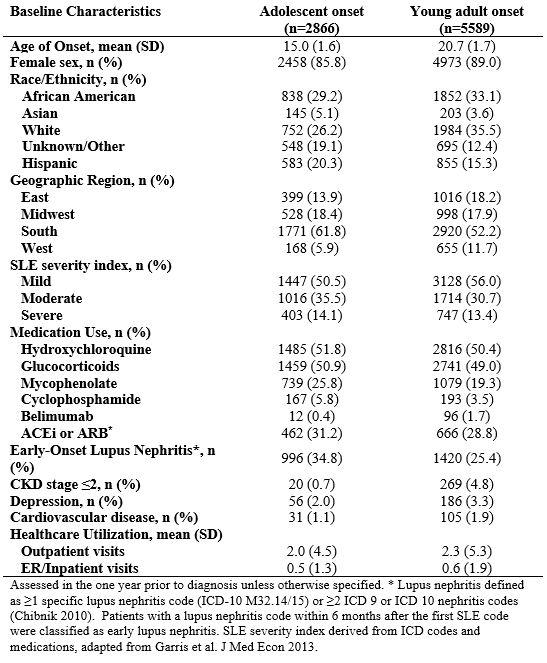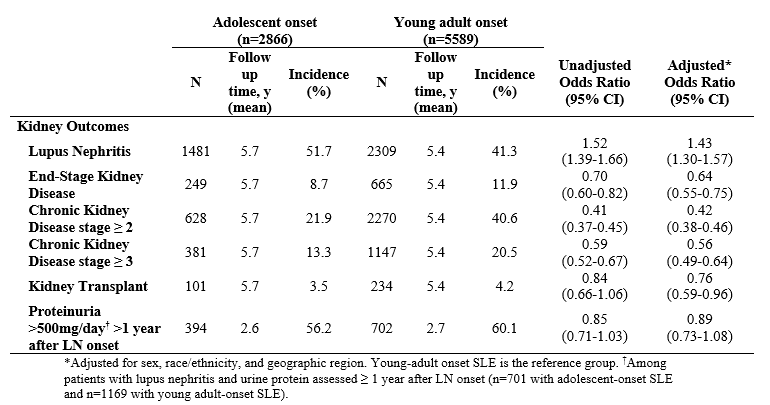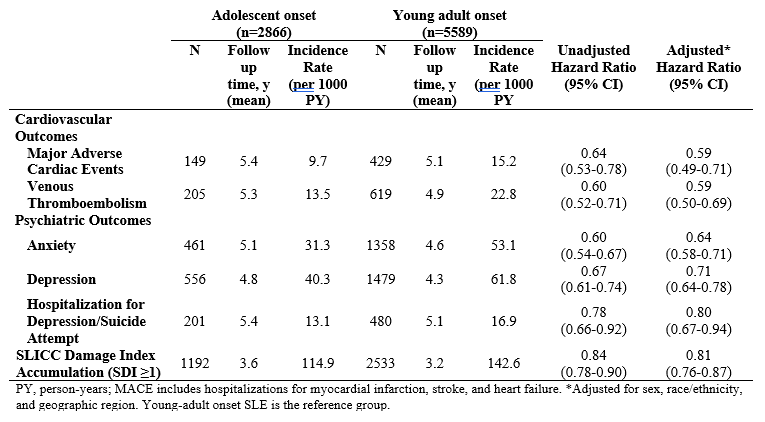Session Information
Date: Tuesday, November 14, 2023
Title: (2257–2325) SLE – Diagnosis, Manifestations, & Outcomes Poster III
Session Type: Poster Session C
Session Time: 9:00AM-11:00AM
Background/Purpose: Adolescent-onset SLE is associated with more severe disease than adult-onset SLE, but young adults may also experience adverse outcomes. We sought to compare disease and damage-related outcomes between adolescent-onset and young adult-onset SLE.
Methods: We conducted a comparative cohort study to assess potential differences in outcomes between patients with adolescent-onset (ages 12-17) vs. young adult-onset (ages 18-23) SLE. Using observational data from a US multi-center electronic health record database, we identified patients with incident SLE (enrolled for ≥ 2 years prior to the first SLE code and met the SLE definition: > 2 SLE ICD codes > 30 days but < 2 years apart). We assessed demographics, SLE severity, early onset lupus nephritis (LN) and baseline comorbidities. We examined kidney outcomes including LN, chronic kidney disease (CKD), end-stage kidney disease (ESKD), transplantation. Among the subset with LN, we also assessed persistent proteinuria, defined as >500mg/day more than one year after LN onset among the subset with LN. We also assessed cardiovascular (CV) events (including major adverse cardiac events and venous thrombosis), psychiatric illness (including hospitalization for depression/suicidality), and SLICC damage index progression. Since LN can occur at SLE onset, kidney outcomes were compared using logistic regression; other outcomes were compared using cox regression to assess incidence rates and hazard ratios. We adjusted for sex, race/ethnicity, and geographic region.
Results: We identified 2866 patients with adolescent-onset and 5589 with young adult-onset SLE (Table 1). Adolescents were less likely to be non-Hispanic White (26 vs. 36%) than young adults. Adolescents had higher rates of moderate and severe SLE disease index scores and higher frequency of early onset LN compared to young adults (35 vs. 25%). Over 2/3 of each group used hydroxychloroquine and glucocorticoids. Over mean 5.7 and 5.4 years follow up, LN was more common in adolescents than young-adult onset SLE patients (adjusted HR 1.43 (1.30-1.57), but CKD, ESRD, and kidney transplant were less frequent than in young adults (Table 2). There was a trend towards a lower risk of persistent proteinuria in adolescents, but this outcome was frequent in both groups with LN (56 vs. 60%). Adolescent-onset SLE was associated with a lower risk of CV events, psychiatric outcomes, and damage accumulation than in young-adult onset SLE (Table 3).
Conclusion: In this comparative cohort study of patients with adolescent and young adult-onset SLE, we found that adolescents have more severe disease at SLE onset, with a higher risk of LN, but they have a lower risk of kidney damage and overall damage progression than young adults, as well as a lower risk of CV and psychiatric morbidity. Among those with LN in both age groups of SLE onset, more than half had persistent proteinuria, which suggests the need to improve outcomes.
To cite this abstract in AMA style:
Materne E, Zhou B, Choi H, Zhang Y, Jorge A. Comparison of Disease Severity and Outcomes in Adolescent-Onset and Young Adult-Onset Systemic Lupus Erythematosus [abstract]. Arthritis Rheumatol. 2023; 75 (suppl 9). https://acrabstracts.org/abstract/comparison-of-disease-severity-and-outcomes-in-adolescent-onset-and-young-adult-onset-systemic-lupus-erythematosus/. Accessed .« Back to ACR Convergence 2023
ACR Meeting Abstracts - https://acrabstracts.org/abstract/comparison-of-disease-severity-and-outcomes-in-adolescent-onset-and-young-adult-onset-systemic-lupus-erythematosus/



